Every cottage garden or pollinator garden can benefit from the colorful flower stalks produced by the gladiolus.
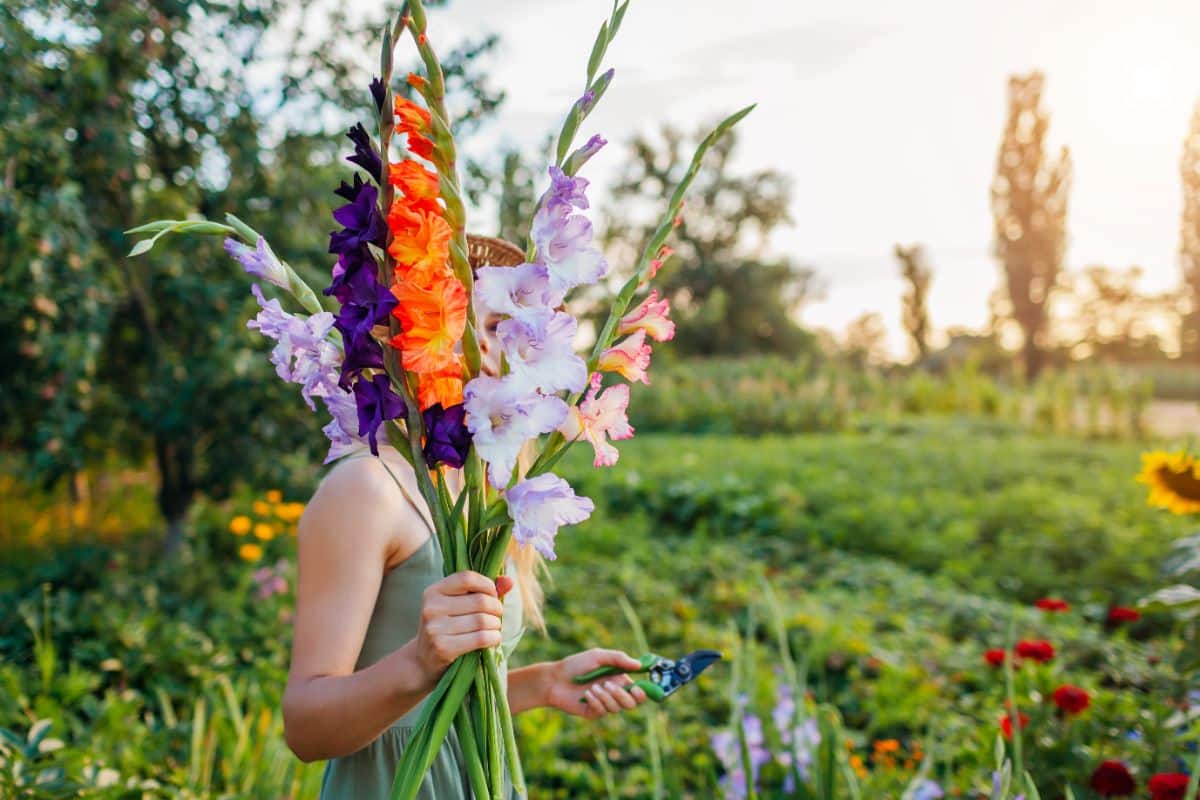
In this article, we will get you started growing gladiolus plants with step-by-step instructions for planting and propagation. We’ll also discuss ideal growing conditions, maintenance and care, and more.
You can jump to any section instantly with the advanced jump below, or read on for the full guide.
Jump to:
- What Are Gladiolus Plants?
- Gladiolus Basics
- Where Do Gladiolus Plants Grow?
- Why Grow Gladiolus Plants?
- When Do Gladiolus Plants Bloom?
- How Long Do Gladiolus Plants Bloom?
- When to Plant Gladiolus Plants
- Ideal Growing Conditions for Gladiolus Plants
- How to Plant Gladiolus Plants
- How to Propagate Gladiolus Plants
- How to Care for Gladiolus Plants
- Recommended Planting Combinations for Gladiolus
- Gladiolus Landscaping Ideas
- Recommended Gladiolus Varieties
- Frequently Asked Questions About Growing Gladiolus Plants
- Where to Buy Gladiolus Plants
What Are Gladiolus Plants?
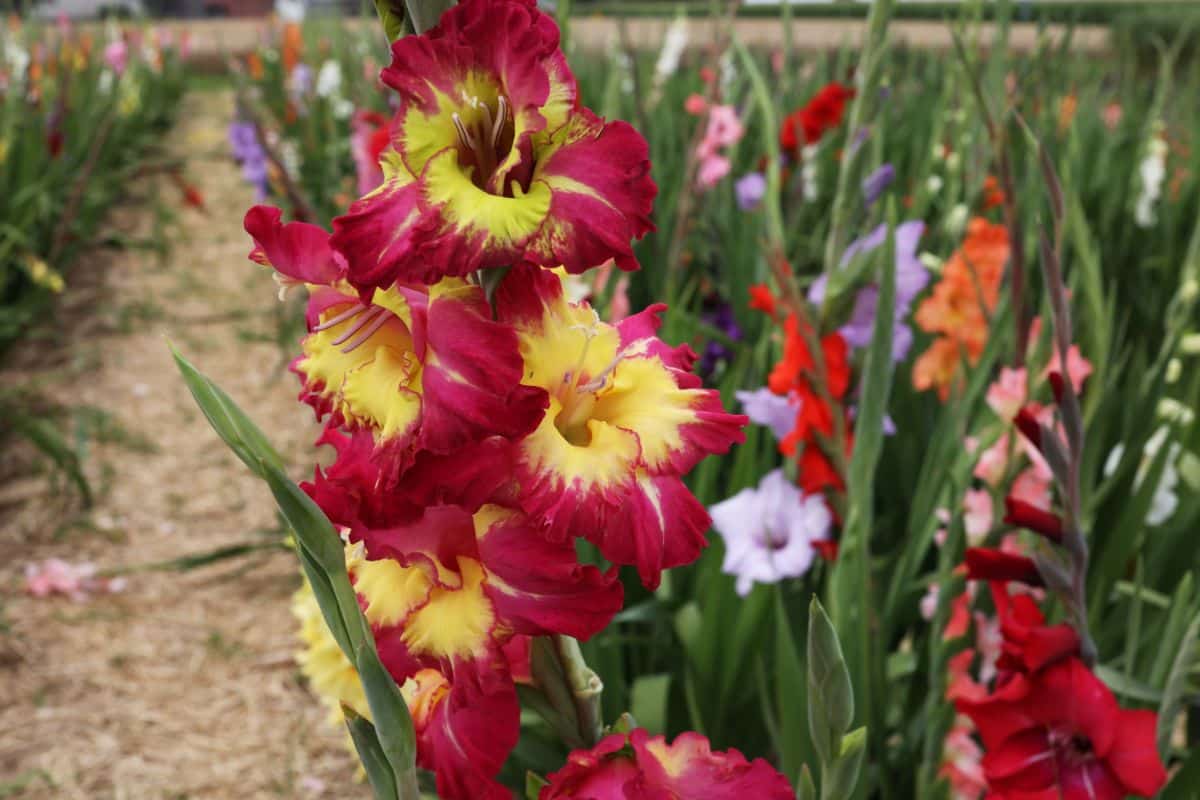
In many a cottage garden, you can behold members of the Gladiolus genus. These stalks of flowers in pink, purple, red, yellow, and orange each stand straight and tall as a sword.
Indeed, gladiolus is known as the “sword lily” and is seen to symbolize character and integrity.
Gladiolus plants belong to the family Iridaceae, which is the iris family. There are around 300 species in this genus.
Gladiolus is August’s birth flower. Incidentally, these flowers were popularized by the band The Smiths, as their singer Morrissey often had them while performing.
You will sometimes see the climate zones listed for gladiolus as 8-10. But you can get away with growing them as perennials in climate zone 7 as well. In some cases, they can also survive in zone 6. The trick is to use quality mulch and pick a cultivar that can handle cold better than most.
Even if you are in zones 3-5, you might not have to give up on the idea of growing gladioli; they have been known to make it even in those climate zones. The Laidback Gardener has a detailed post on this topic that is worth checking out.
Gladiolus Basics
| Zones: | 7-10 (and possibly colder) |
| Blooming season: | Summer through fall |
| Expected height: | Up to 4 feet |
| Soil: | Well-drained loamy soil |
| Sun: | Full to partial (full is best) |
Where Do Gladiolus Plants Grow?
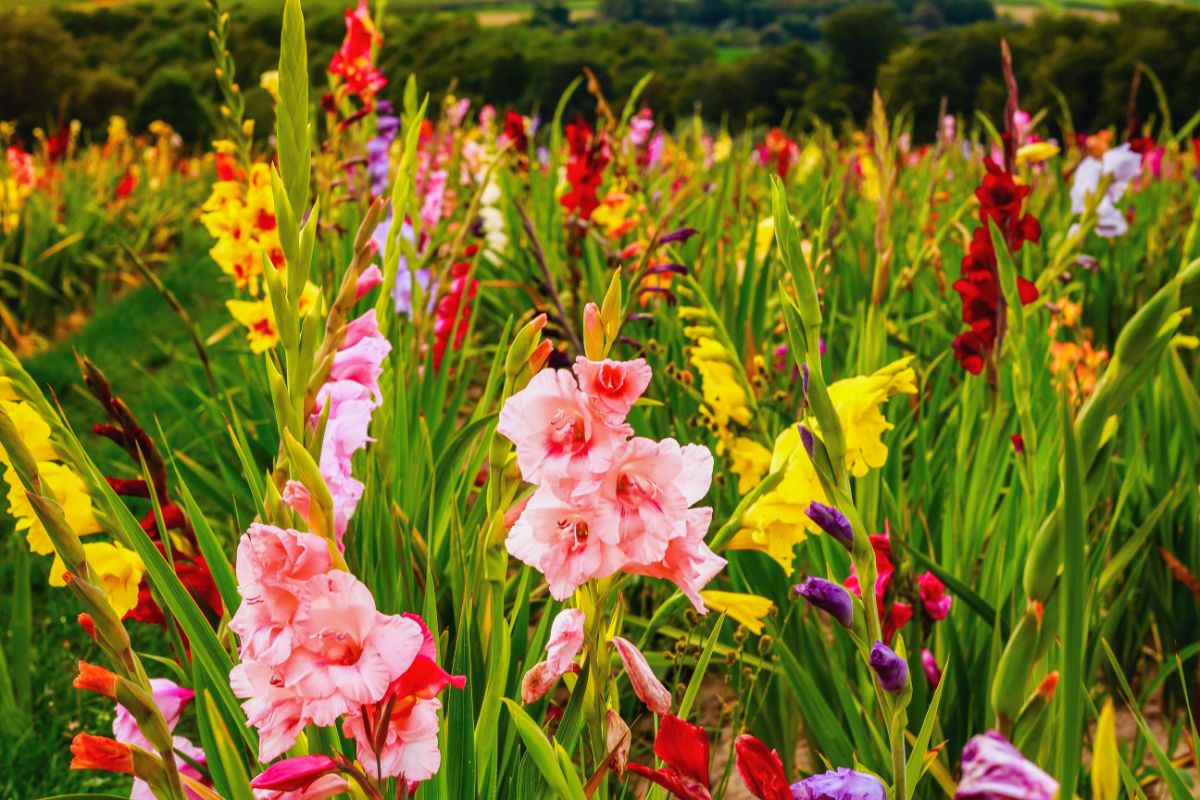
The most diverse abundance of gladiolus species can be found growing in South Africa. Gladiolus is also prominent in other parts of Africa, as well as Asia and the Mediterranean areas of Europe.
Because gladiolus grows well in a number of climate zones and is a pretty hardy perennial plant, it has been cultivated successfully beyond these regions as well.
Why Grow Gladiolus Plants?
There are so many benefits to growing gladioli in your garden! Here are just a few:
● The cottage garden look: Tall spikes of flowers like those gladioli produce are a classic component of the traditional cottage garden. So, planting gladioli is an easy way for you to start creating a cottage garden of your own.
● Attract pollinators: Hummingbirds and other pollinators find the trumpet-shaped flowers just as delightful as you do and may come around to your garden more frequently once they spot these tall perennials.
● Surprisingly affordable: Are you used to paying an arm and a leg for bulb flowers? If so, you might feel nervous about adding more to your garden. But when you see how affordably priced most gladiolus corms are, you will be amazed.
● Endless variety: The array of colors for gladiolus plants will blow your mind. Whether you want something bright and vivid or something muted and subtle, you will find it.
● Blooms in succession: If you stagger your planting and/or shop for early- and late-blooming cultivars, you can get gladiolus blooms to brighten your garden for months.
● Easy to grow: Gladiolus is a simple, low-maintenance plant that even beginners can grow.
● Hardier than they seem: Even in colder regions where gladiolus is marketed as an annual, you can sometimes get it to grow as a perennial (with or without overwintering indoors, depending on the specific circumstances).
When Do Gladiolus Plants Bloom?

Gladioli begin blooming in July, with flowers continuing to blossom throughout summer and fall. The plants will stop blooming when the first frost arrives.
How Long Do Gladiolus Plants Bloom?
When a gladiolus stalk blooms, you will see the flowers on the bottom open first. Then, the middle flowers will open, followed by the flowers on top. Each individual flower may last anywhere from 1-2 weeks.
If you want to enjoy months of gladiolus blooms, the trick is to plant multiple gladioli but spread out the dates when you plant them and/or purchase cultivars with earlier and later bloom times. That way, when one plant finishes, another will begin.
When to Plant Gladiolus Plants
You can begin planting gladiolus a couple of weeks before you expect the last spring frost. You may continue planting them all the way through the start of July.
Ideal Growing Conditions for Gladiolus Plants
For your gladiolus plants to produce healthy stalks packed with abundant blooms, they need to have the right sun, soil, and water conditions. Let’s go over their requirements now.
How Much Sun Do Gladiolus Plants Need?
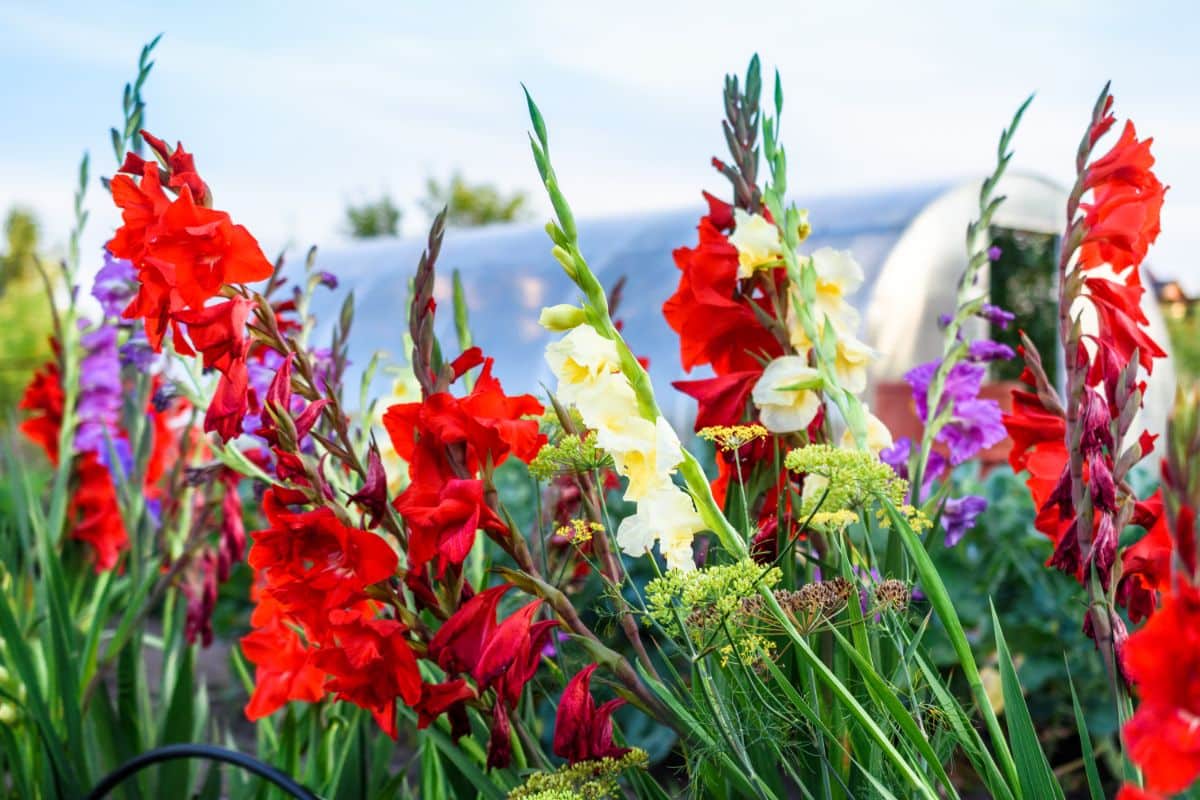
Sunny locations are best for gladiolus plants. If you can give them full sun, they will reward you with the largest number of beautiful blooms.
You can plant them in partial shade if you cannot find a spot in full sun. The blooms might not be as abundant, and the plants might also be more likely to flop over, but they should still look beautiful if you take proper care of them.
What Type of Soil is Right for Gladiolus Plants?
The soil type preferred by gladioli is moist but well-drained soil, specifically loamy soil or sandy soil.
Ideally, this well-drained garden soil should have average richness. A mildly acidic pH can be beneficial, but neutral is also okay.
Be aware that heavy soils can pose problems with respect to drainage, so you may need to loosen them up with amendments before planting gladiolus.
How Much Water Do Gladiolus Plants Need?
Plenty of water is necessary for gladiolus to thrive. Most of the time, you will need to provide about an inch of water per week.
Water plants in raised beds extra if they need it, as well as those in containers. Both of these can dry out more readily than your regular garden beds.
Gladiolus also may struggle during drought conditions. So, during especially dry times, be sure to provide them with the extra water they need.
How to Plant Gladiolus Plants
Gladioli can grow happily in your flower beds and also make excellent container plants. Let’s go over step-by-step instructions for planting them in both.
Ground Planting
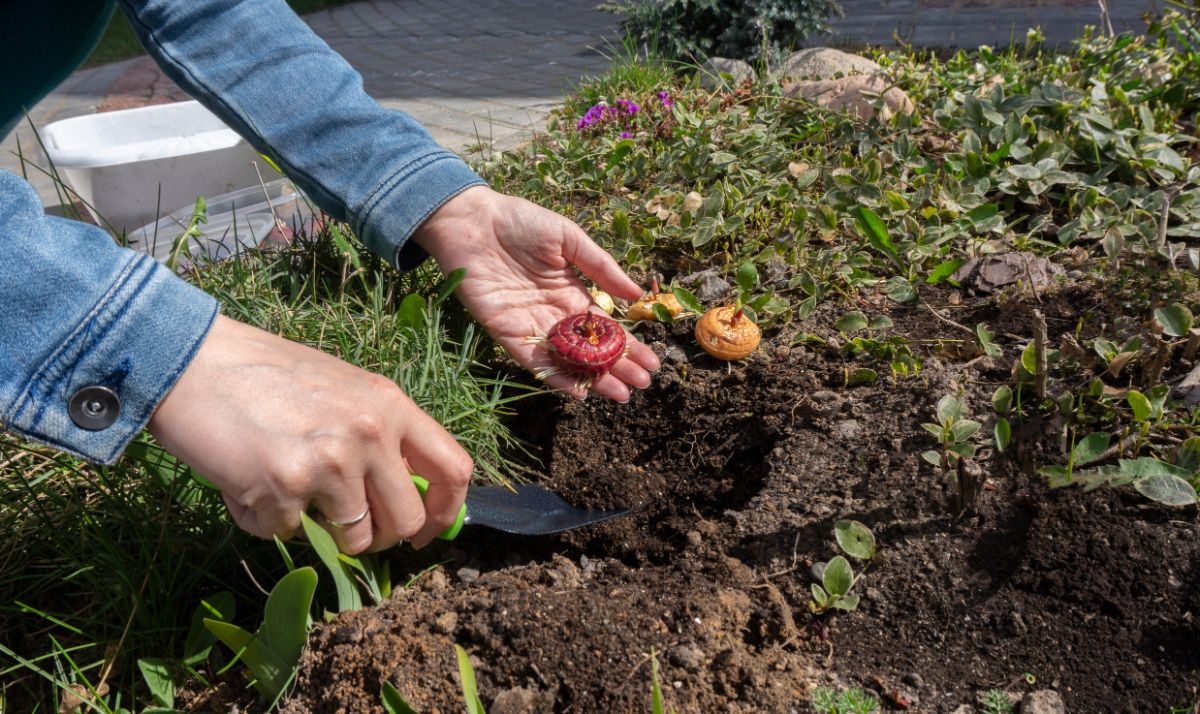
1. First, decide where in your garden you will plant gladiolus corms, following our recommendations for optimum sunlight and soil.
2. Prepare the soil for the bulbs. Gladiolus usually responds well to compost amendments, which can enrich the soil while improving drainage.
You might need to take some additional steps for adequate drainage when planting gladiolus in clay soil, however, such as creating some raised garden beds.
3. Dig holes for your corms. Space apart the corms 6-10”. Each corm should be buried anywhere from 2-6” down once you finish backfilling the soil. The “eyes” should be facing upward.
4. Water well.
Container Planting
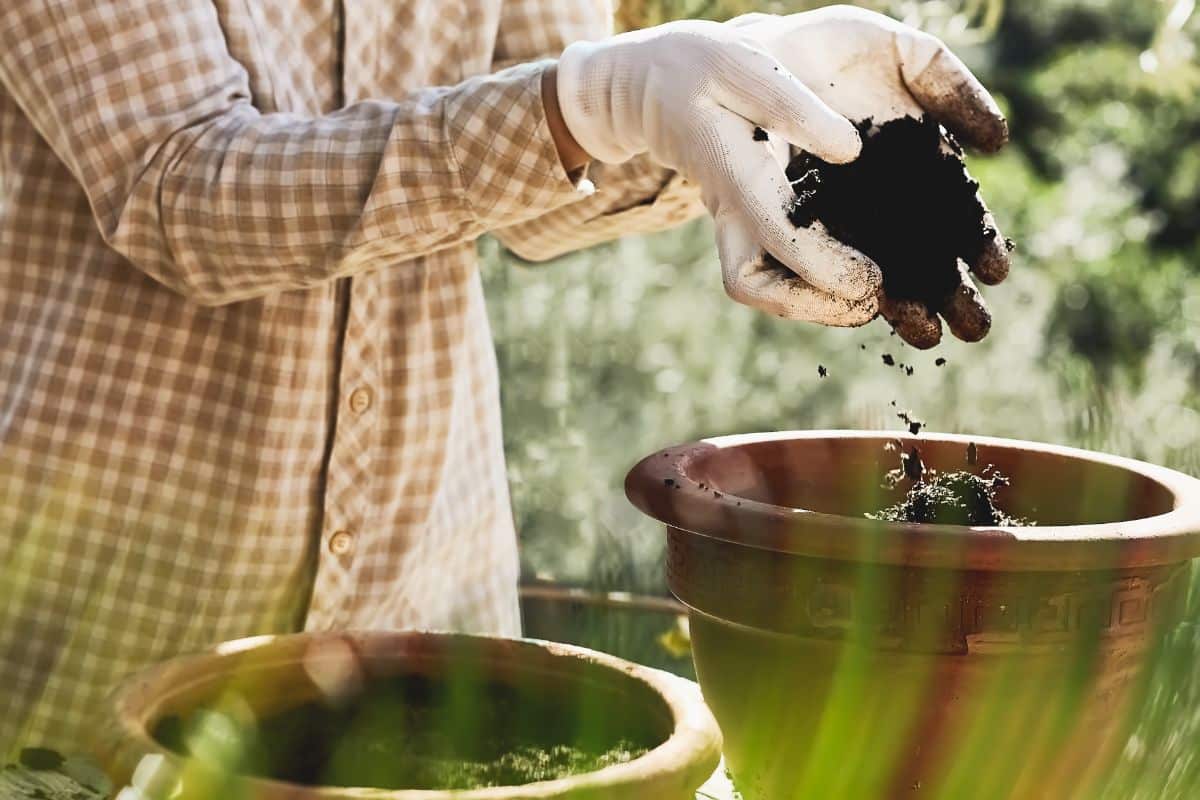
1. Before you plant corms in pots, choose the best pots for the job. Gladiolus grown in pots requires stakes, which means that you need a really deep container. As always, it also needs drainage holes.
2. Consider putting a layer of rocks or gravel at the bottom.
3. Next, add potting soil with a loamy consistency.
4. Add a bit of all-purpose fertilizer, preferably with a slow-release formula.
5. Put the corm in the container and finish filling in the soil.
6. Water well.
7. Find a sunny spot for your gladiolus container plant.
Some people wait to stake their gladioli until they start growing tall, but you might want to consider inserting the stake during the planting process. You can do it right before you add the corm.
How to Propagate Gladiolus Plants
There are two ways you can propagate gladioli in your garden: either collect the seeds and grow new gladiolus plants from them or dig up your gladioli now and again to take divisions. Let’s explain the step-by-step instructions for both of these propagation techniques.
Starting Gladiolus Plants from Seed
1. First, harvest the gladiolus seeds (unless you are planting seeds from the store). Wait for your gladiolus blooms to wilt. Instead of deadheading as you might regularly do, wait for the petals to drop. Have the seed pods turned brown? That means you can now collect the pods. If they are still green, wait for them to turn brown first.
2. Take the pods indoors and open them. The seeds will fall out.
You can store the seeds somewhere cool, dark, and dry until you are ready to proceed with the next steps.
3. Get some small containers with drainage holes and fill them with starter mix. Sow the seeds on the surface.
4. Add a very thin layer of sand to the top of the seeds. They should still be able to get light.
5. Pick a bright place for your seeds to germinate where they will stay warm.
6. Mist the starter mix with a spray bottle to get it moist, ensuring you do not wash out the seeds. Return periodically to mist the mix so that it does not dry out.
7. After about 4-5 weeks, the seedlings will sprout. Continue caring for them until they form some true leaves.
8. Harden the seedlings by taking them outdoors for progressively longer periods so that they adapt.
9. Once the danger of frost has passed, you can transplant them into larger outdoor containers or your garden beds.
How to Divide Gladiolus Plants
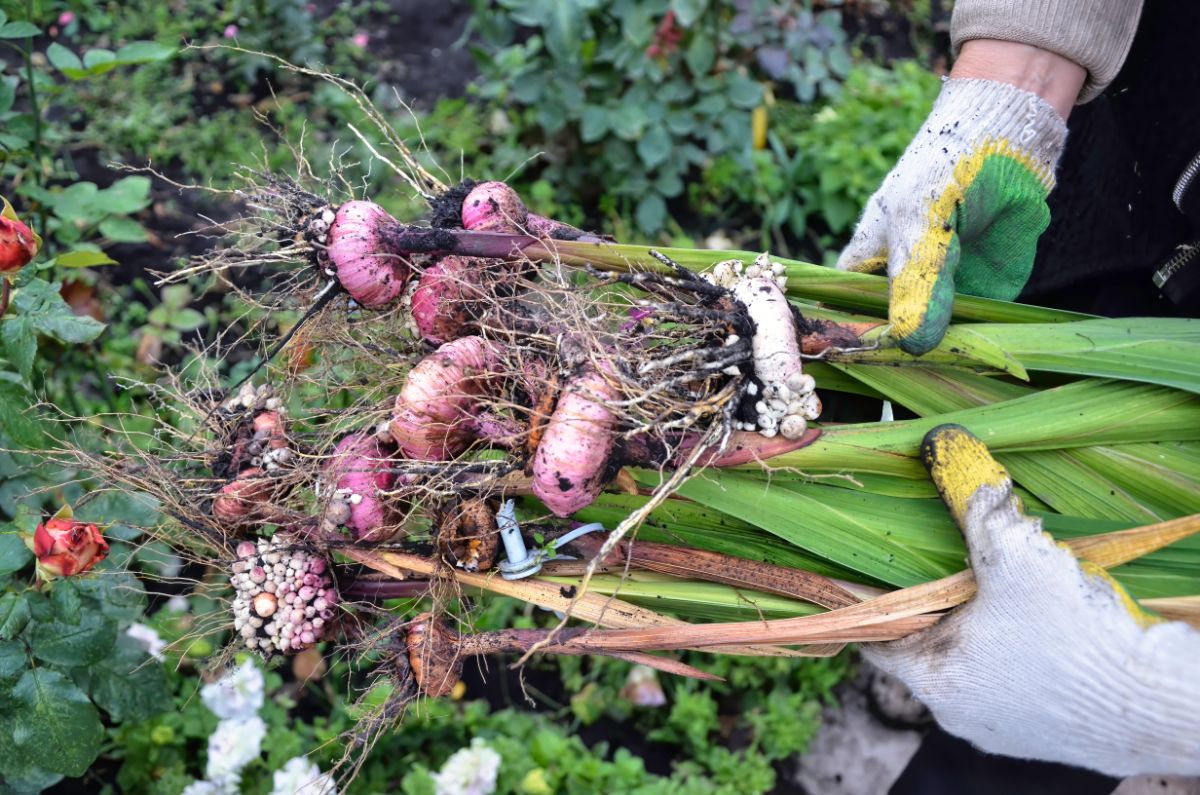
1. Use a trowel to dig in a circle carefully around a gladiolus plant, avoiding the roots.
2. Push the trowel underneath the plant and lift it up from the ground.
3. Wipe away the excess dirt so you can have a clearer view.
4. You should notice that the corm of the plant has produced what looks like miniature copies of itself called “cormels.”
Remove these cormels. If the corm itself has spawned any other larger corms, you can break them off from the original as well.
5. Plant the new corms and cormels.
Be aware that small cormels need more time to develop once you transplant them compared to larger corms.
As a result, they are unlikely to produce a blooming plant in the first year. Be patient though, and you will soon have many more gladioli in your garden.
How to Care for Gladiolus Plants
Maintaining gladioli is pretty easy, but there are a few things you should know about mulching, staking, and more. Let’s go over gladiolus care instructions.
How to Fertilize Gladiolus Plants
It is typically recommended that you fertilize gladioli during the planting process. Try using 5-10-10 (NPK) fertilizer or alternately 5-10-5. Add it before you plant the corm. Do not allow the corm to come into direct contact with the fertilizer. If you do, the fertilizer could burn it.
How to Mulch Gladiolus Plants
Adding mulch around gladiolus plants in spring is a good way to keep the soil nice and moist and prevent weeds from taking over. Bark mulch or straw mulch are good options.
If your gladioli are staying in the ground over the winter, you should mulch again in the fall. This time, add a slightly thicker layer to help prevent major temperature fluctuations in the soil.
How to Stake Gladiolus Plants
If you have a taller variety of gladiolus or your gladioli are not well-sheltered, they might tend to flop over.
You can prevent flopping by staking your gladioli. Carefully insert a bamboo post into the ground next to your gladiolus, and then use twine to attach the plant to the stake.
As your gladiolus grows taller, you may need to revisit it and add more ties.
It is important not to injure the roots of your plants when you are adding your stakes. So if you have good reason while you are planting to believe you will need to stake the gladioli, you should think about adding the stakes before you plant them instead of after.
How to Prune Gladiolus Plants
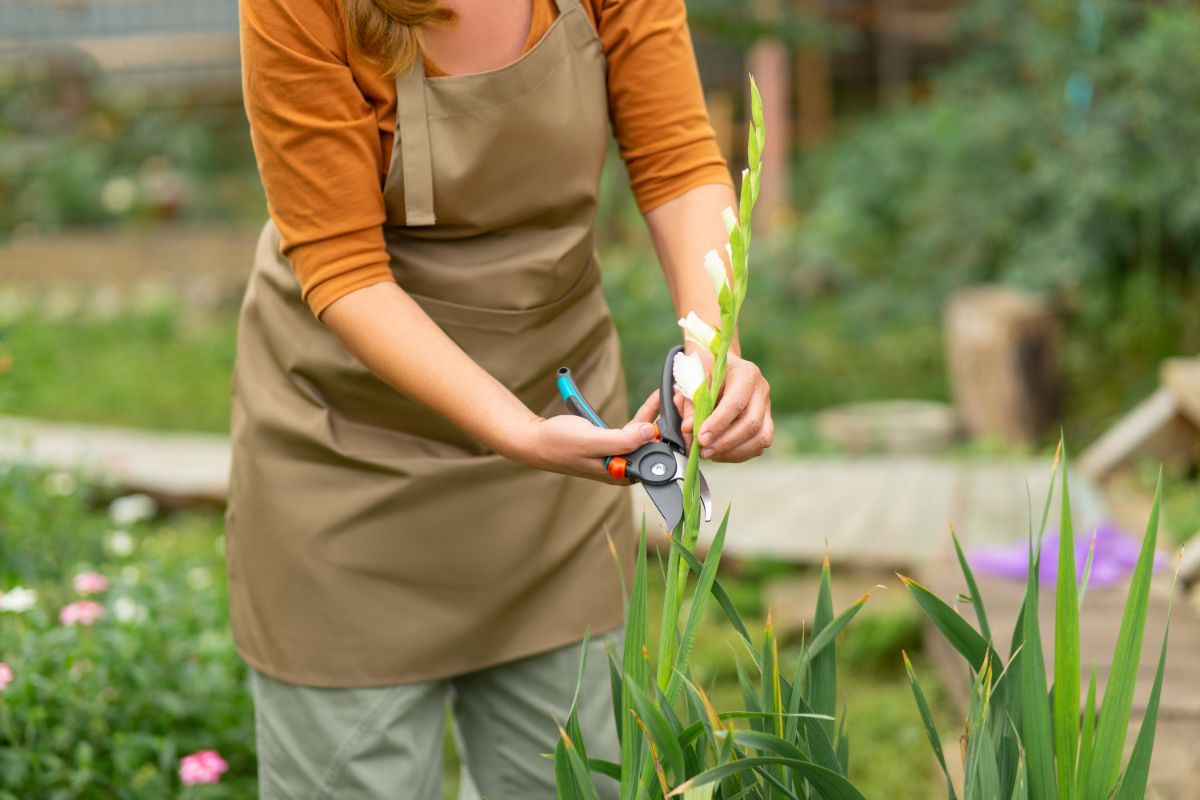
Pruning your gladiolus plants includes both deadheading and trimming.
How to Deadhead Gladiolus Plants
You can either deadhead your gladioli by plucking off individual flowers as they wilt or by waiting for entire spikes to wilt and then removing the spikes themselves.
When to Cut Back Gladiolus Plants
As with many other perennials in your garden, you can cut back gladiolus at the end of the season. Wait for the leaves to turn yellow, and then trim the plant. This will keep the area around the plant tidy and help to prevent pests and rot over the winter.
How to Overwinter Gladioli
Speaking of winter, in some climate zones, gladioli are not winter-hardy and require extra protection from winter temperatures. That means you will need to dig up the corms for winter storage.
Iowa State University offers the following instructions for overwintering gladiolus bulbs:
“Dry the corms for 2 to 3 weeks in a warm, dry, well-ventilated location. When thoroughly dry, remove and discard the old, dried-up mother corms located at the base of the new corms. Remove the tiny corms (cormels) found around the base of the new corms. Save the small corms for propagation purposes or discard them. Place the corms in mesh bags or old nylon stockings and hang them in a cool, dry, well-ventilated location. Storage temperatures should be 35 to 45 degrees Fahrenheit.”
Are Gladiolus Plants Vulnerable to Diseases or Pests?
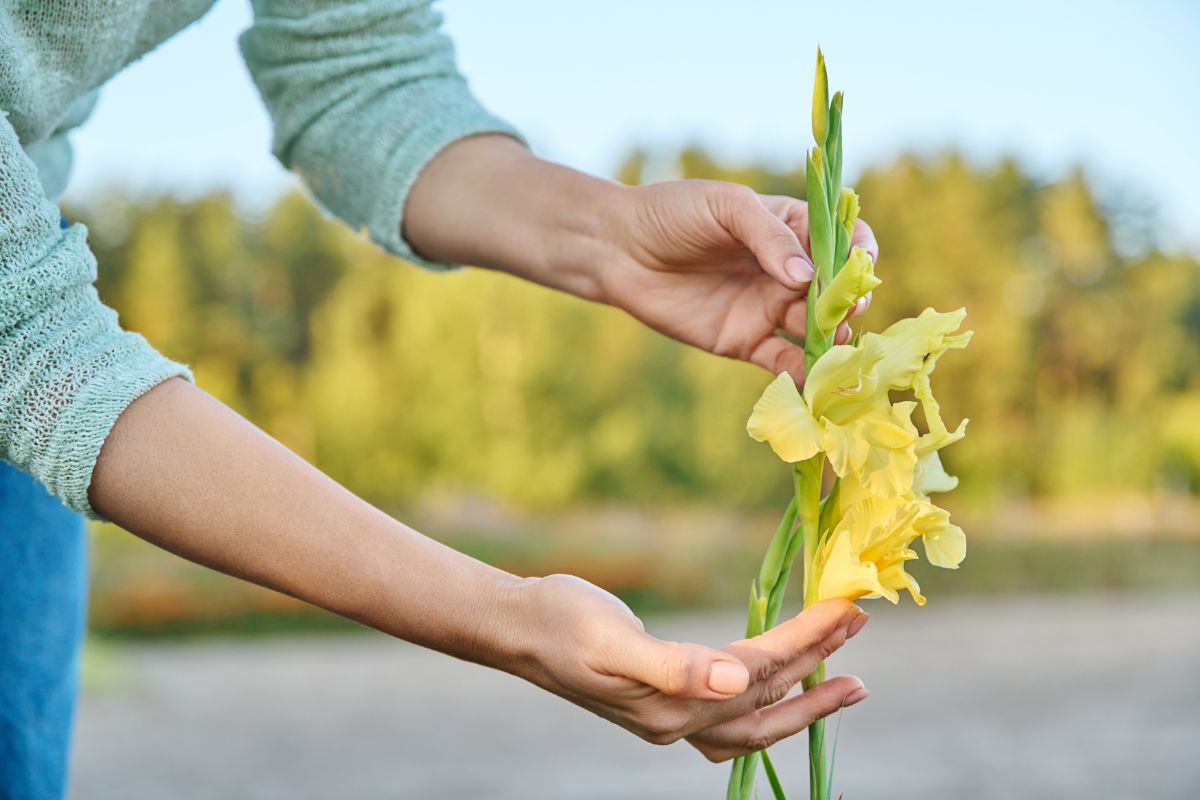
It is no surprise that, like any other plant in your garden, gladiolus may sometimes be afflicted by disease or targeted by pests.
Some diseases to watch out for include botrytis leaf, corm rot, stem rot, yellow wilt, storage rot, scab, mosaic, bacterial blight, and rust.
Insects that can cause issues for gladioli include cutworms, plant bugs, gladiolus thrips, zebra caterpillars, tulip aphids, and two-spotted spider mites.
The Connecticut State Connecticut Agricultural Experiment Station provides detailed descriptions of each of these pests and diseases.
Slugs and snails may sometimes eat gladiolus. Generally speaking; this plant is considered to be deer-resistant and rabbit-resistant as well. Despite the fact that the plant is toxic to rabbits, however, some gardeners do report problems with them.
Recommended Planting Combinations for Gladiolus
What plants make good companions for the flower spikes of gladioli? Here are a few recommendations:
● Peonies: These plants like full to partial sunlight and rich, well-draining, moist soil. Depending on what zone you are in, you can plant either the herbaceous or tree varieties, which will bloom in spring and summer. They can look lovely interspersed with gladiolus in a border. Take a look at our Peonies Full Growing Guide to get started with this companion planting idea.
● Dahlias: Flourishing in well-drained soil and full sun, dahlias make a wonderful accompaniment to gladiolus, blooming during summer and fall. See our Dahlias Full Growing Guide.
● Hollyhocks: Another cottage garden favorite with a similar appearance to gladiolus is the hollyhock, which likewise produces tall stalks of colorful blooms. Hollyhocks like rich, moist, well-draining soil and full sun, and blossom in summer and fall. They tend to be taller than gladiolus, sometimes reaching up to 9 feet. So, consider planting them behind your gladioli.
Gladiolus looks great with a wide range of other perennials, so you can find a lot of other exciting ideas for planting combinations!
Gladiolus Landscaping Ideas
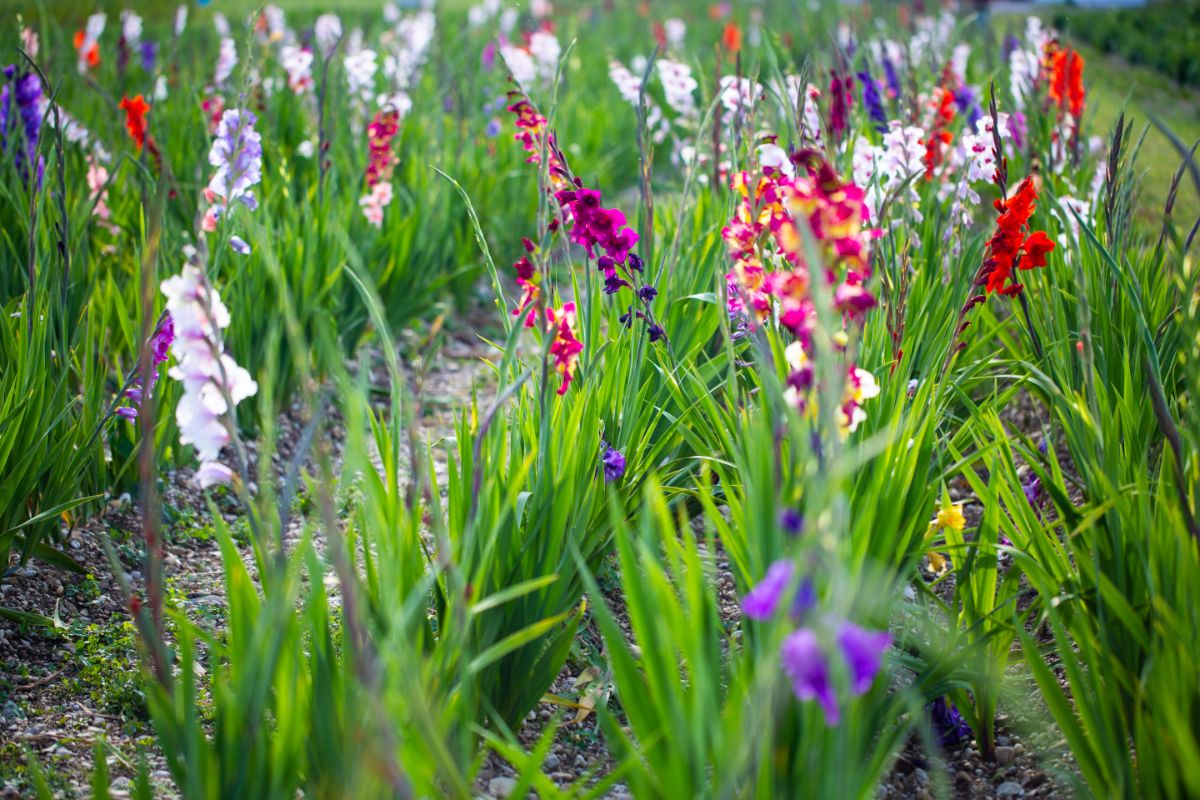
Here are a few ideas for how you can use gladiolus in your garden to the best effect:
● Plant along a fence or wall: These flower stalks are perfect for planting in rows alongside fences and walls—but keep in mind that you may want to make sure you are planting all the same type when you do this, at the same time. That way, they will bloom concurrently. A succession of flowers planted in a row may look kind of sparse since not all of the plants will be in flower at once.
● Bed of gladiolus: Massing gladioli together may work better if you want a succession of blooms throughout the season since the plants will be a bit more dense than those you plant in rows and borders. Even with only some of them in bloom at any given time, they will still create a look and feel of abundance.
● Surround a bench: If you have a bench in your flower garden, you can frame it dramatically with gladioli.
● Borders: Gladiolus borders to either side of a walkway can really draw the eye along the path, producing an inviting effect.
● Container garden: You can bring so much color and life to your patio when you grow gladioli in pots.
Recommended Gladiolus Varieties

There are dozens upon dozens of striking gladiolus cultivars out there to bring bright colors to your garden. Let’s take a look at some recommendations.
● White Prosperity: If you want spectacular white blooms, consider this cultivar of gladiolus. Rising as high as 5 feet, these spikes will catch your attention from anywhere in your garden.
● Jester: This type of gladiolus features ruffled petals in yellow. The centers are a contrasting red.
● Purple Flora: The range of colors for gladiolus even includes a deep, dark, vivid purple. You will be amazed at the level of saturation in every bloom.
● Espresso: Another option for dark gladiolus blooms is Espresso, a cultivar that is a dark blood-red hue.
● Black Star: If you want to really make a statement, try interspersing Black Star gladioli among white or light-hued cultivars for a bold contrast. Black Star produces blooms that are a deep, dark red that looks almost black around the edges of the petals.
● Mon Amour: One of the most eye-catching of all gladiolus cultivars is Mon Amour, a variety that features bi-color blooms in pale pink and yellow. It will blossom in mid-summer, inviting pollinators to your garden.
● Green Star: There are not a whole lot of flowers you can plant that has a green hue, but Green Star gladioli are a special exception.
● Smokey: These lovely blooms have a muted smokey mauve color, perfect for bringing a more subtle effect to your garden.
● Hardy Gladiolus Elvira: The blooms of this cultivar are such a light shade of pink they look almost white. There are darker reddish-pinkish marks on the petals for a distinctive look. You can get away with growing these as perennials, even in zone 5.
● Hardy Gladiolus Atom: Another cultivar of gladiolus that is hardy to zone 5 is this one, featuring magnificent deep red petals. White edges make every individual petal stand out.
● Princess Margareth Rose: If you love warm, sunny hues, consider planting this cultivar. The blooms are a mixture of yellow and peachy orange. It is a favorite among pollinators.
● Red Balance: If what you want is a classic deep red through and through, then choose this exciting cultivar. Hummingbirds in your area are going to love it!
● Strong Gold: Do you want yellow blooms? Then one of the top cultivars you should think about planting is Strong Gold, with its large, showy flowers.
● Buggy: If you want gladiolus blooms that look almost like daffodil flowers, try planting Buggy in your garden. Each flower has yellow petals surrounded by white ones, providing a very daffodil-like appearance.
● My Love: These beautiful gladiolus stalks feature white blossoms with little stripes of dark pink all along the edges.
● Karma: For pale coral blooms, consider planting this frilled beauty.
● Guinea: One distinctive cultivar that can make a striking statement in any garden is the Guinea gladiolus. Its petals include shades of pink, apricot, and red, along with subtle white streaks.
● Zizane: Among the most astonishing types of gladiolus is this one, which includes white petals streaked with blood red.
● Fringed Coral Lace: For a gladiolus that provides textural interest, look to this cultivar, named for the delicate, fringed appearance of its peach petals.
● Cantate: Those in search of pink flowers to add to a cottage garden will love the cheerful look of Cantate.
● Thalia: For a bright medium purple, think about adding the Thalia cultivar to your garden this year.
● Plum Tart: This cultivar features light pinkish blooms with darker edges.
● Luca: Are you looking for an exciting dwarf cultivar of gladiolus? Luca only rises to about 26”, which makes it much shorter than most other types of gladioli. These plants rarely require staking and feature blossoms in pale lavender which are just a shade darker around the edges.
● Abyssinian gladiolus: This type of gladiolus has a very different appearance from most others. Instead of producing tall stalks of densely-packed blooms, it offers arcing white flowers with dark centers that are more loosely spread out. Indeed, if you did not know this was a gladiolus, you might mistake it for something else entirely.
● Ajax: This unique cultivar’s ruffled blooms are white with contrasting red throats.
● Hybrid Gladiolus Essential: These tall gladiolus plants produce large white flowers.
● Peach Melba: The peach and yellow hues of the blooms on this cultivar have a look that is nothing short of delicious. Of course, you should not actually eat them, but you’ll probably find yourself wishing you could (we recommend you just eat actual peach melba instead).
● Volbeat: Another option for really dark flowers is this one, which produces bluish-purple blooms.
● Peter Pears: The light orange blossoms on this cultivar will probably remind you more of peaches than they do of pears.
● Passos: This cultivar’s blooms are a light purple color with darker purple in their throats and matching dark streaks throughout their petals. During July and August, they are sure to become one of the main attractions in your perennial garden.
While you can shop for gladiolus cultivars individually, you can also find mixes that contain more than one variety.
Frequently Asked Questions About Growing Gladiolus Plants
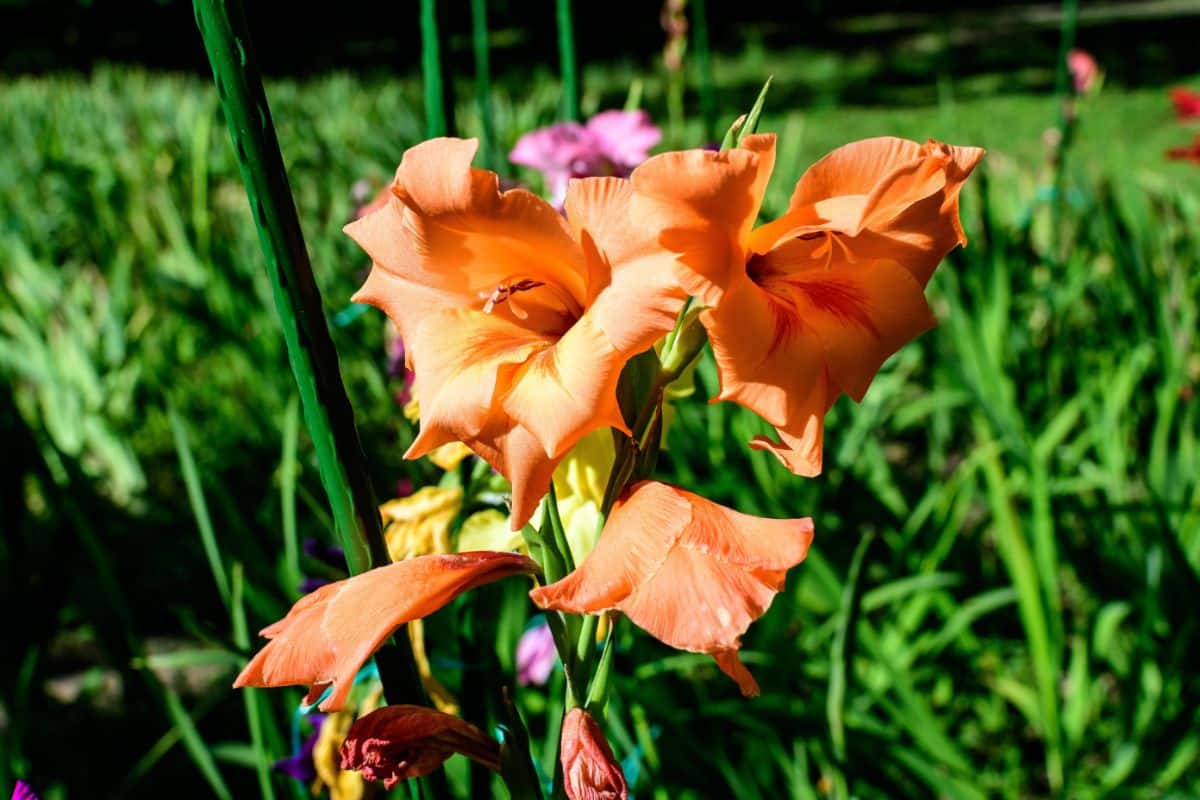
If something is eating your gladiolus, it is probably insects, slugs, or snails. Mammals are less likely, but not impossible.
Gladioli are perennials, but they are sometimes sold as annuals in climate zones where they are not hardly.
Sometimes, yes, gladiolus flowers may be used in funerals and memorial services. This is because the meaning of the flower is linked to the strength of character. By displaying gladioli or sending them in honor of a deceased person’s memory, you are complementing their character.
No, they are not. The corms are quite affordable, to begin with, plus you can propagate them easily.
Gladiolus is poisonous to dogs, cats, rabbits, horses, and other animals, so keep your pet from munching on it—especially the bulbs.
If your pet does eat gladiolus, the toxic effects could produce symptoms like lethargy, excess salivation, diarrhea, and vomiting. Contact your vet if you notice these symptoms or suspect your pet has just consumed the plant.
Where to Buy Gladiolus Plants
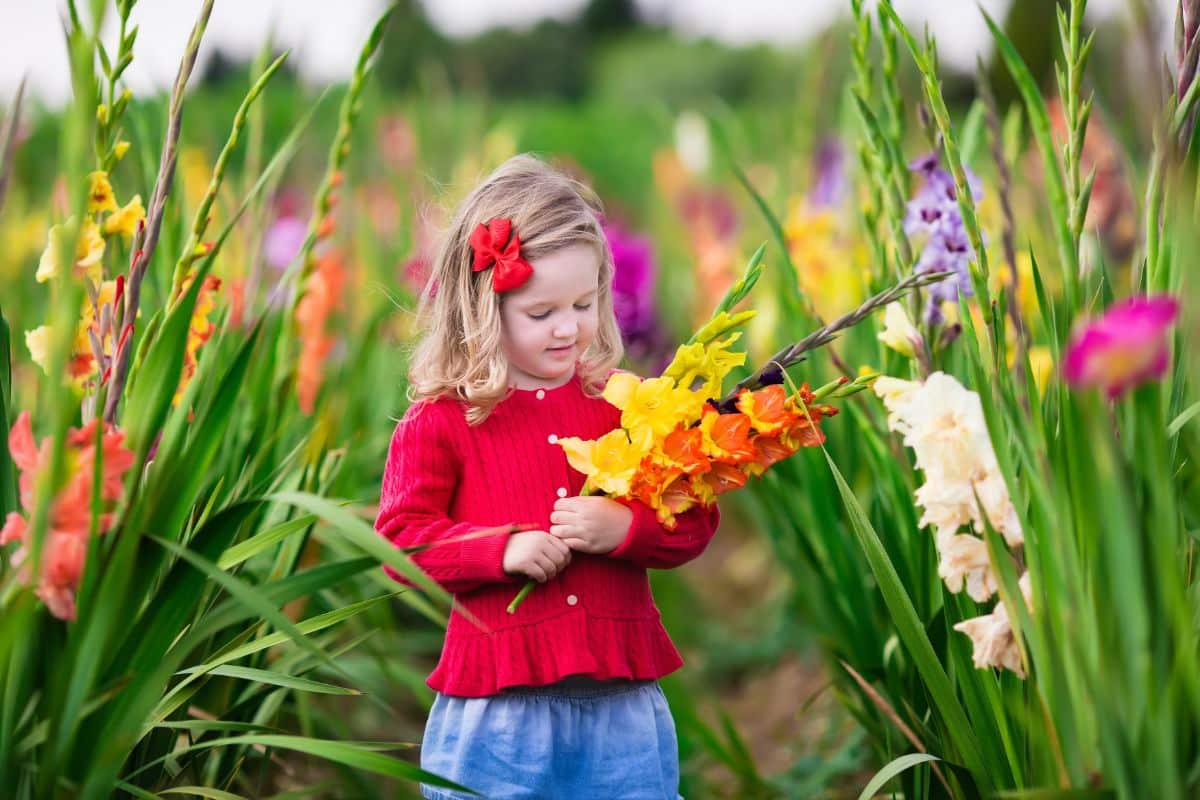
If you are excited to bring tall stalks of colorful flowers to your perennial garden, you can shop gladiolus plants online for the biggest selection.

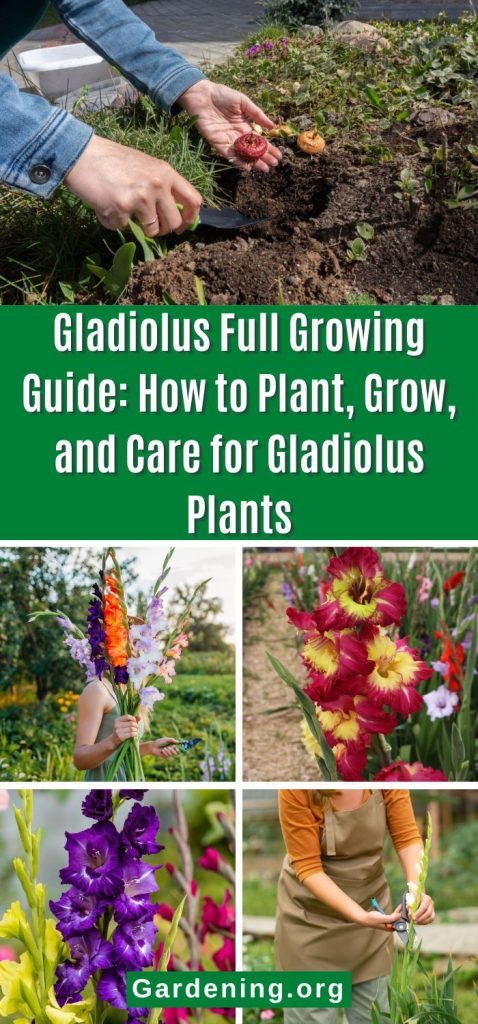
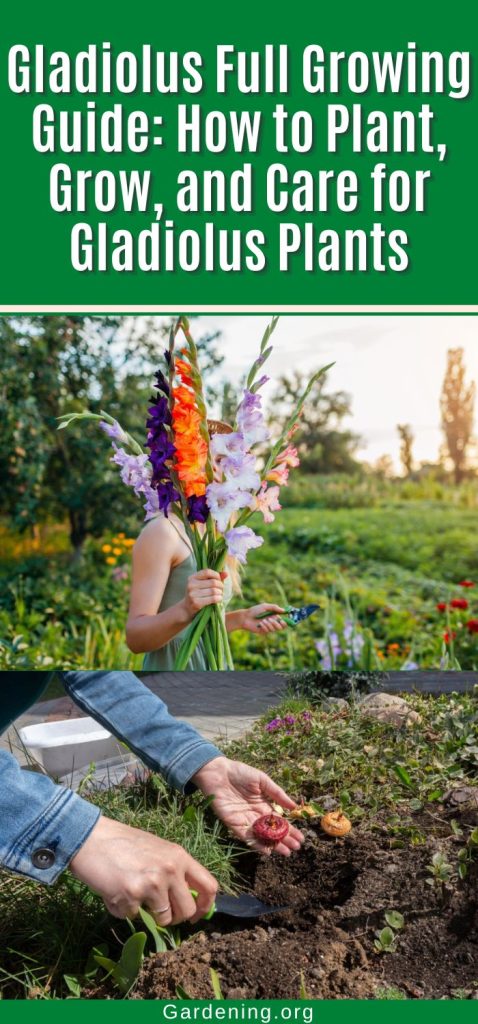
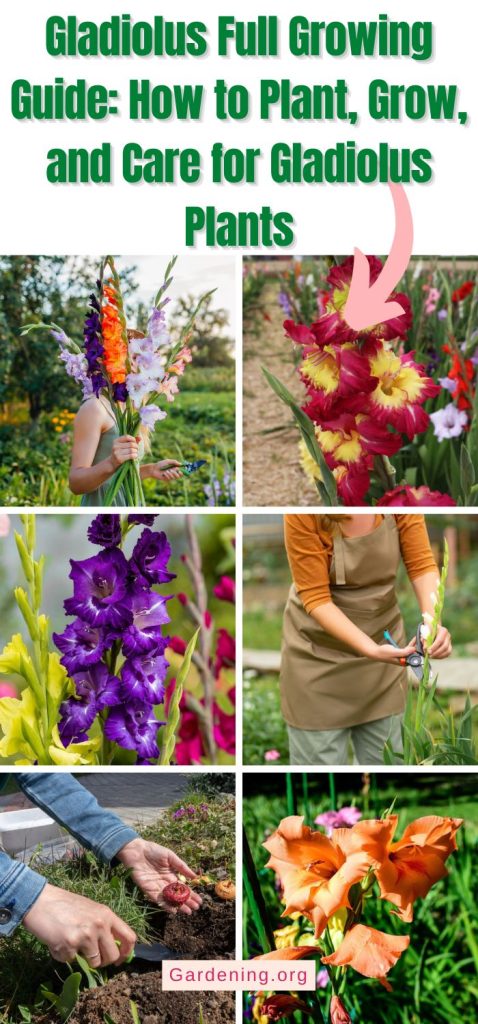
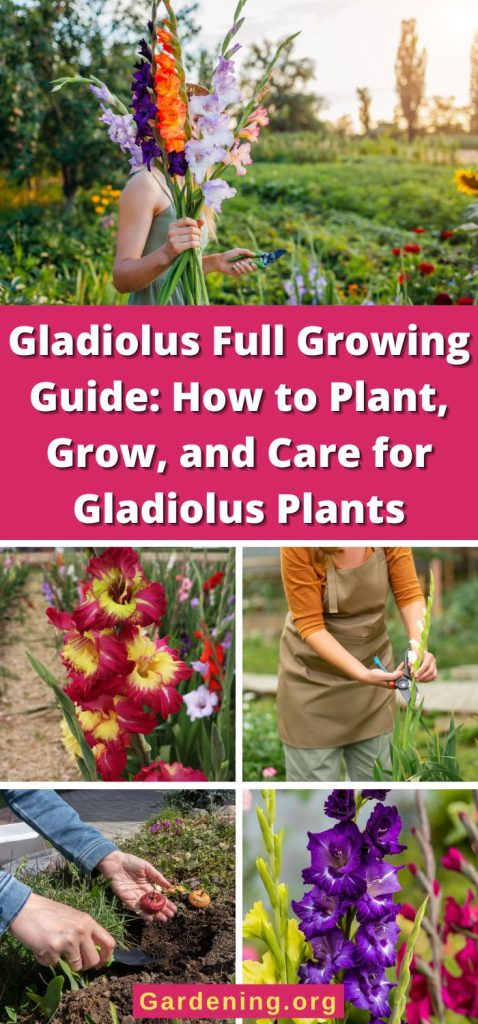

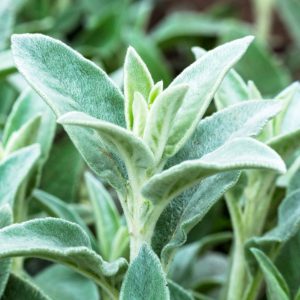


Leave a Reply